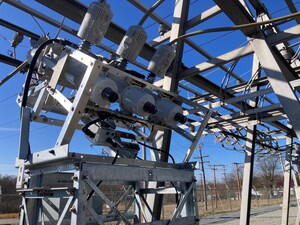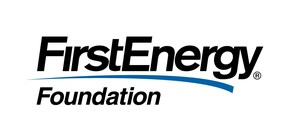FirstEnergy, Dominion Energy, American Electric Power reach joint planning agreement to propose regional transmission projects across PJM footprint
Companies jointly propose electric transmission projects to serve region's growing power demand through PJM's competitive planning process
Collaboration leverages expertise of industry leaders to propose comprehensive, cost-effective solutions that promote regional grid reliability
AKRON, Ohio, Oct. 7, 2024 /PRNewswire/ -- FirstEnergy Corp., Dominion Energy Virginia and American Electric Power have entered into an innovative joint planning agreement to propose several new regional electric transmission projects across multiple states within the PJM footprint.
The innovative collaboration comes at a time when efficient and cost-effective regional transmission development is essential and encouraged by the Federal Energy Regulatory Commission (FERC), the independent federal agency that regulates the interstate transmission of electricity.
Power demand in the PJM region is growing at an unprecedented pace due to rapid expansion of energy-intensive industries such as data centers, the electrification of transportation and heating, and increased manufacturing onshoring. At the same time, the region's power generation mix is changing as legacy generation is retired and more renewables are added to the grid.
"Energy-intensive industries, electrification and the energy transition all rely on a robust power grid," said Mark Mroczynski, President, FirstEnergy Transmission. "By drawing upon the combined experience of three leading transmission developers, we can take the proactive steps needed to build new infrastructure that will ensure our communities have the power they need for sustained health and economic growth in the future."
"This dynamic environment requires more regional collaboration to develop large-scale 'backbone' transmission infrastructure that spans across the areas served by our three companies," said Ed Baine, President of Dominion Energy Virginia. "By leveraging the expertise and resources of three industry leaders whose transmission zones border one another, we're better able to develop superior and more cost-effective solutions required to effectively resolve reliability issues across the PJM region. These projects are more comprehensive and will be more effective than what each of our companies would be able to develop individually."
"AEP operates the largest transmission network in the nation and has more experience building 765-kV infrastructure than any other company in the U.S.," said Bob Bradish, Senior Vice President, Regulated Infrastructure Investment Planning for AEP. "The solutions we have proposed to address the rapidly evolving energy demand we are seeing across the region will enable us to continue providing reliable service and drive economic growth."
The companies jointly proposed the projects through PJM's Regional Transmission Expansion Plan (RTEP) Open Window process in September. PJM is the regional transmission organization that coordinates the transportation of wholesale electricity across a 13-state region. The proposed projects include several new 765-kV, 500-kV and 345-kV transmission lines in Virginia, Ohio and West Virginia.
The projects remain in the early stages of development. If selected by PJM, the companies would then undertake an extensive, multi-year process to select routes, perform environmental studies, engage with communities, obtain state and local permitting and build the projects.
In addition to the joint proposals, each of the three companies have also submitted individual proposals for other transmission projects consistent with how each company has participated in past PJM open windows.
About FirstEnergy
FirstEnergy Corp. (NYSE: FE), is dedicated to integrity, safety, reliability and operational excellence. Its electric distribution companies form one of the nation's largest investor-owned electric systems, serving more than six million customers in Ohio, Pennsylvania, New Jersey, West Virginia, Maryland and New York. The company's transmission subsidiaries operate approximately 24,000 miles of transmission lines that connect the Midwest and Mid-Atlantic regions. Follow FirstEnergy online at firstenergycorp.com and on X @FirstEnergyCorp.
About Dominion Energy
Dominion Energy (NYSE: D), headquartered in Richmond, Va., provides regulated electricity service to 3.6 million homes and businesses in Virginia, North Carolina, and South Carolina, and regulated natural gas service to 400,000 customers in South Carolina. The company is one of the nation's leading developers and operators of regulated offshore wind and solar power and the largest producer of carbon-free electricity in New England. The company's mission is to provide the reliable, affordable, and increasingly clean energy that powers its customers every day. Please visit DominionEnergy.com to learn more.
About AEP
AEP, headquartered in Columbus, OH, owns and operates more than 40,000 miles of transmission lines, the nation's largest electric transmission system, and more than 225,000 miles of distribution lines to deliver power to 5.6 million customers in 11 states. AEP also is one of the nation's largest electricity producers with approximately 29,000 megawatts of diverse generating capacity. AEP is investing $43 billion over the next five years to make the electric grid cleaner and more reliable. AEP participates in the competitive transmission space through Transource, a jointly owned transmission company with Evergy, headquartered in Kansas City, Missouri.
Forward-Looking Statements: This news release includes forward-looking statements within the meaning of the Private Securities Litigation Reform Act of 1995 based on information currently available to management. Such statements are subject to certain risks and uncertainties and readers are cautioned not to place undue reliance on these forward-looking statements. These statements include declarations regarding management's intents, beliefs and current expectations. These statements typically contain, but are not limited to, the terms "anticipate," "potential," "expect," "forecast," "target," "will," "intend," "believe," "project," "estimate," "plan" and similar words. Forward-looking statements involve estimates, assumptions, known and unknown risks, uncertainties and other factors that may cause actual results, performance or achievements to be materially different from any future results, performance or achievements expressed or implied by such forward-looking statements, which may include the following: the potential liabilities, increased costs and unanticipated developments resulting from government investigations and agreements, including those associated with compliance with or failure to comply with the Deferred Prosecution Agreement entered into July 21, 2021 with the U.S. Attorney's Office for the Southern District of Ohio; the risks and uncertainties associated with government investigations and audits regarding Ohio House Bill 6, as passed by Ohio's 133rd General Assembly ("HB 6") and related matters, including potential adverse impacts on federal or state regulatory matters, including, but not limited to, matters relating to rates; the risks and uncertainties associated with litigation, arbitration, mediation and similar proceedings, particularly regarding HB 6 related matters, including risks associated with obtaining dismissal of the derivative shareholder lawsuits; changes in national and regional economic conditions, including recession, volatile interest rates, inflationary pressure, supply chain disruptions, higher fuel costs, and workforce impacts, affecting us and/or our customers and those vendors with which we do business; variations in weather, such as mild seasonal weather variations and severe weather conditions (including events caused, or exacerbated, by climate change, such as wildfires, hurricanes, flooding, droughts, high wind events and extreme heat events) and other natural disasters affecting future operating results and associated regulatory actions or outcomes in response to such conditions; legislative and regulatory developments, including, but not limited to, matters related to rates, energy regulatory policies, compliance and enforcement activity, cyber security, and climate change; the risks associated with physical attacks, such as acts of war, terrorism, sabotage or other acts of violence, and cyber-attacks and other disruptions to our, or our vendors', information technology system, which may compromise our operations, and data security breaches of sensitive data, intellectual property and proprietary or personally identifiable information; the ability to meet our goals relating to employee, environmental, social and corporate governance opportunities, improvements, and efficiencies, including our greenhouse gas ("GHG") reduction goals; the ability to accomplish or realize anticipated benefits through establishing a culture of continuous improvement and our other strategic and financial goals, including, but not limited to, overcoming current uncertainties and challenges associated with the ongoing government investigations, executing Energize365, our transmission and distribution investment plan, executing on our rate filing strategy, controlling costs, improving credit metrics, maintaining investment grade ratings, and growing earnings; changing market conditions affecting the measurement of certain liabilities and the value of assets held in our pension trusts may negatively impact our forecasted growth rate, results of operations, and may also cause us to make contributions to our pension sooner or in amounts that are larger than currently anticipated; mitigating exposure for remedial activities associated with retired and formerly owned electric generation assets, including those sites impacted by the recently promulgated legacy coal combustion residual rules; changes to environmental laws and regulations, including, but not limited to, rules recently finalized by the Environmental Protection Agency and the Securities and Exchange Commission ("SEC") related to climate change; changes in customers' demand for power, including, but not limited to, economic conditions, the impact of climate change, emerging technology, particularly with respect to electrification, energy storage and distributed sources of generation; the ability to access the public securities and other capital and credit markets in accordance with our financial plans, the cost of such capital and overall condition of the capital and credit markets affecting us, including the increasing number of financial institutions evaluating the impact of climate change on their investment decisions; future actions taken by credit rating agencies that could negatively affect either our access to or terms of financing or our financial condition and liquidity; changes in assumptions regarding factors such as economic conditions within our territories, the reliability of our transmission and distribution system, generation resource planning, or the availability of capital or other resources supporting identified transmission and distribution investment opportunities; the potential of non-compliance with debt covenants in our credit facilities; the ability to comply with applicable reliability standards and energy efficiency and peak demand reduction mandates; human capital management challenges, including among other things, attracting and retaining appropriately trained and qualified employees and labor disruptions by our unionized workforce; changes to significant accounting policies; any changes in tax laws or regulations, including, but not limited to, the Inflation Reduction Act of 2022, or adverse tax audit results or rulings; and the risks and other factors discussed from time to time in our SEC filings.
Dividends declared from time to time on FirstEnergy Corp.'s common stock during any period may in the aggregate vary from prior periods due to circumstances considered by FirstEnergy Corp.'s Board of Directors at the time of the actual declarations. A security rating is not a recommendation to buy or hold securities and is subject to revision or withdrawal at any time by the assigning rating agency. Each rating should be evaluated independently of any other rating.
These forward-looking statements are also qualified by, and should be read together with, the risk factors included in FirstEnergy Corp.'s Form 10-K, Form 10-Q and in FirstEnergy's other filings with the SEC. The foregoing review of factors also should not be construed as exhaustive. New factors emerge from time to time, and it is not possible for management to predict all such factors, nor assess the impact of any such factor on FirstEnergy Corp.'s business or the extent to which any factor, or combination of factors, may cause results to differ materially from those contained in any forward-looking statements. FirstEnergy Corp. expressly disclaims any obligation to update or revise, except as required by law, any forward-looking statements contained herein or in the information incorporated by reference as a result of new information, future events or otherwise.
SOURCE FirstEnergy Corp.

WANT YOUR COMPANY'S NEWS FEATURED ON PRNEWSWIRE.COM?
Newsrooms &
Influencers
Digital Media
Outlets
Journalists
Opted In





Share this article